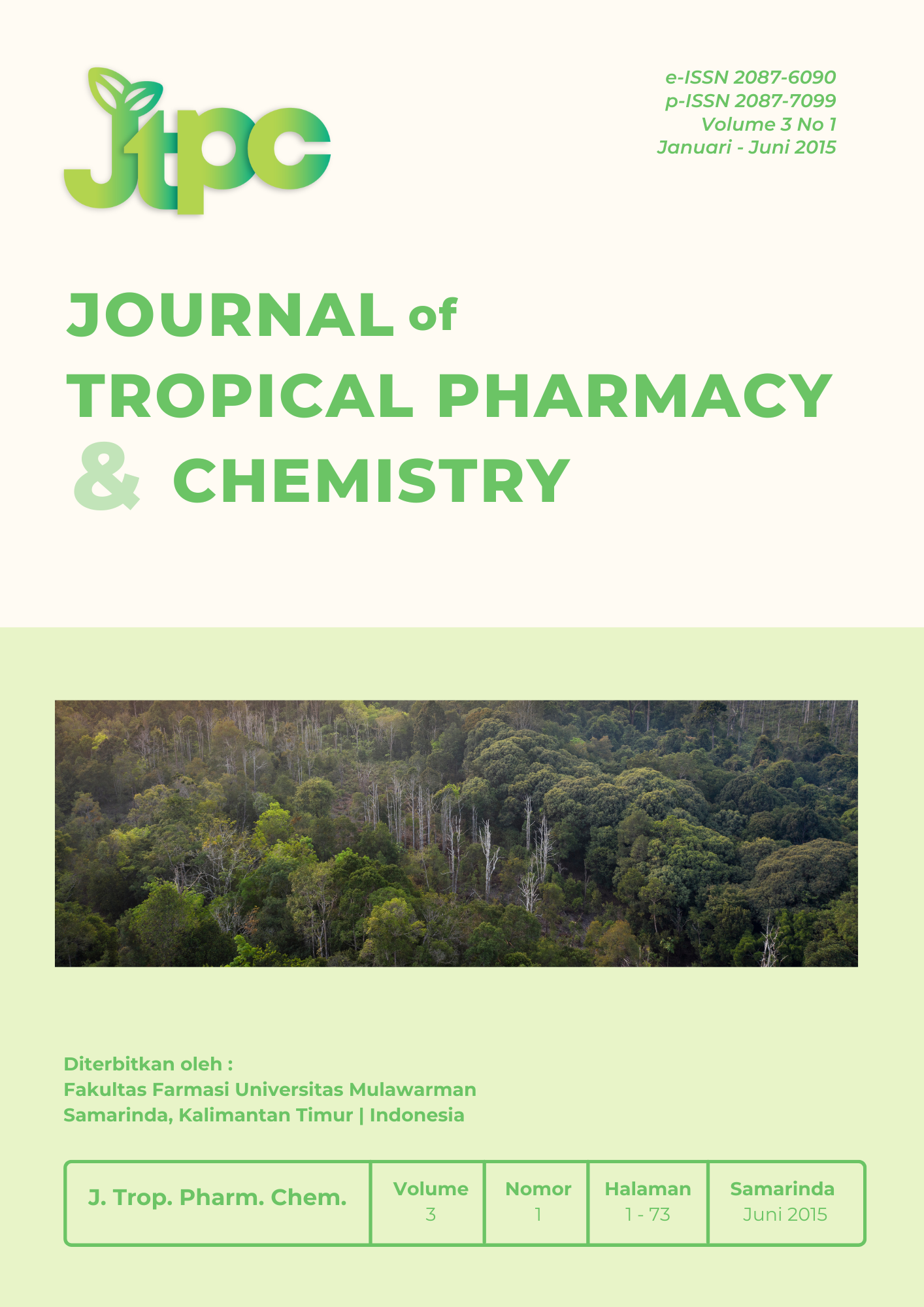Formulasi Krim dari Kulit Buah Kakao (Theobroma cacao L.) Berkhasiat Antioksidan
Keywords:
cocoa pod husk, antioxidant, cream, physics stability, Span 60- Tween 60Abstract
A research about the antioxidant cream formulation from cocoa (Theobroma cacao L.) pod husk extract have been done. The research was aimed to formulate cream from extract of cocoa pod husk with high antioxidant activity and physically stable. Fresh cocoa pod husk was extracted with both of ethanol-water (7:3) and acetone-water (7:3), then both of extracts was tested their antioxidant activities by DPPH (2,2-diphenyl-1-picrylhidrazyl) method. The acetone-water (7:3) extract which have the higher antioxidant activity (IC50 = 0,08 mg/ml toward DPPH free radical) was formulated become cream preparation with variated emulsifying agents, i.e. anionic emulsifier (stearic-triethanolamine (TEA) with vary concentrations of TEA i.e. 1%, 2% and 3%) and nonionic emulsifier (Span 60-Tween 60 3%, 4% and 5%). The result of research indicated that antioxidant cream with Span 60-Tween 60 3% as emulsifying agent was the most physically stable cream.
Downloads
References
1.Amiruddin, M.D. 2003. Ilmu Penyakit Kulit. Bagian Ilmu Penyakit Kulit dan Kelamin Fakultas Kedokteran Universitas Hasanuddin. Makassar. 165
2.Anonim. 2004. Keputusan Badan Pengawasan Obat dan Makanan Republik Indonesia. Departemen Kesehatan RI. Jakarta.1. 1972.
3.Anonim. 2005. Farmakope Indonesia. Edisi IV. Departemen Kesehatan Republik Indonesia. Jakarta. 6
4.Anonim. Potensi Limbah Coklat. http://www.bagnak. ditjennak.go.id. Diakses tanggal 13 Maret 2006
5.Arlorio, M., Coisson, J.D., Travaglia, F., Varsaldi, F., Miglio, G., Lombardi, G., & Martelli, A. 2005. Antioxidant and Biological Activity of
Pigments from Theobroma cacao Hulls Extracted with Supercritical CO2 .http://www.worldcocoafoundation.org/Library/Document/ArlorioPhenolicAntioxidantsinCacaoHullsPhysiology.pdf, diakses tanggal 29 Mei 2006
6.Banker, G.S., Rhodes, C.T. 1997. Modern Pharmaceutics Drugs and The Pharmaceutical Science. 7th Volume. Marcel Dekker Inc. New York and Basel. 355
7.Baumann, L. 2002. Cosmetic Dermatology. Principles and Practise. The McGraw-Hill Companies. Medical Publishing Division. New York
8.Figueira, A., Janick, J., & Bemiller, J.N. 1993. New Products from Theobroma cacao. www.host.purdene.edu/newcrop/proceeding1993/ html, diakses tanggal 30 Juni 2006
9.Gennaro, A.R. 1990.Remington and Practice of Pharmacy. 18th Edition,.
Philadelphia College of Pharmacy and Science. Philadelphia. 301-302
10.Hagerman, A.E., Klucher K.M. 1986. Tannin-Protein Interaction. In : Plant Flavanoids in Biology and Medicine.Ed. Cody V. New York
11.Halliwel, B., John, M.G., 1999. Free Radical in Biology and Medicine 3rd edition. London: Oxford University Press
12.Harborne, J. B. 1987. Metode Fitokimia : Penuntun Cara Modern Menganalisis Tumbuhan. Penerbit ITB Bandung. 70
13.Husaini, M.A. 1991. Gizo, Proses Penuaan dan umur Panjang. Majalah Cermin Dunia Kedokteran No. 73 : 22,23
14.Keithler, W.R.M. 1956. The Formulation of Cosmetics and Cosmetic Specialities, Drug and Cosmetic Industry. New York. 3
15.Lachman, L., Lieberman, H.A., Kanig, J.L., 1994. Theory and Practice of Pharmacy. John Wiley and Sons. New York. 508, 549
16.Lautan, J. 1997. Radikal Bebas Pada Eritrosit dan Lekosit. Cermin Dunia Kedokteran No.116
17.Martin, E.L. 1971. Dispensing of Medication.7th Edition.
Mack Publishing Company. Easton Pensylvania. 528, 529
18.Mossu, G. 1992. Cocoa The Tropical Agriculturalist.The Macmillan Press LTD, London, 17.
19.Muhilal. 1991. Teori Radikal Bebas dalam Gizi dan Kedokteran. Majalah Cermin Dunia Kedokteran No. 73: 10
20.Murray, R.K., Granner, D.K., Mayes, P.A., Rodwell, V.W. 2000. Biokimia Harper. Terjemahan oleh Andry Hartono. 2003. Penerbit Buku Kedokteran. EGC. Jakarta. 613, 618-619
21.Rohman, A., Sugeng, R. 2005. Jurnal Aktivitas pengikatan radikal bebas
DPPH Minyak buah merah Daun Kemuning (Murraya paniculata (L) Jack) secara In Vitro.Majalah Farmasi Indonesia. Lab. Kimia Analisis, Bagian kimia Farmasi, Fakultas Farmasi Universitas Gadjah Mada. Yogyakarta. 136-140
22.Sadikin, N. Antioksidan eksogen dan penilaian status antioksidan. Disampaikan pada Kursus Penyegar Radikal Bebas dan Antioksidan dalam Kesehatan: Dasa, Aplikasi dan Pemanfaatan Bahan Alam. Jakarta. 24 Maret 2001
23.Sastrohamidjojo, H., 1985, Spektroskopi. Penerbit Liberty, Yogyakarta. 11-15
24.Slaga, T.J., Keuneke, R. The Detox Revolution. Terjemahan oleh Lea Roosa. 2005. PT Bhuana Ilmu Populer. Jakarta. 16
25.Soeatmadji, D.J. The role of free radicals in management of type 2 diabetic patients. Disampaikan pada Simposium Free Radicals in Diabetes and Their Interaction with Sulfonilurea. Jakarta. 24 Maret 2001
26.Soewoto, H. Antioksidan eksogen sebagai lini pertahanan kedua dalam menanggulangi peran radikal bebas. Disampaikan pada Kursus Penyegar Radikal Bebas dan Antioksidan dalam Kesehatan: Dasar, Aplikasi dan
Pemanfaatan Bahan Alam. Jakarta. 24 Maret 2001
27.Sunanto, H., 1994. Cokelat Budidaya, Pengolahan Hasil, dan Aspek Ekonominya. Penerbit Kaninus. Yogyakarta. 13, 100, 101
28.Tjitrosoepomo, G. 1994. Taksonomi Tumbuhan Obat-Obatan. Gadjah Mada University Press. Yogyakarta. 213.
29.Tominaga, H. 2005. DPPH Radical-Scavenging Effect of Several Phenilpropanoid Compounds and Their Glycoside derivates. The Pharmaceutical Society of Japan. 371-375
30.Winarno, F.G. 1997. Kimia Pangan dan Gizi. PT. Gramedia Pustaka Utama. Jakarta. 12




